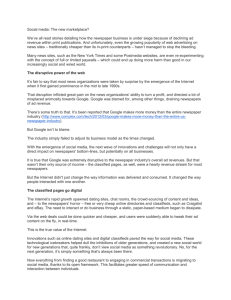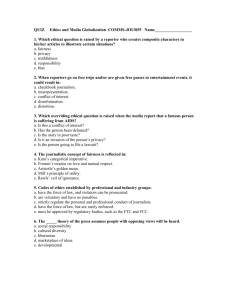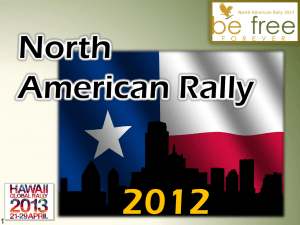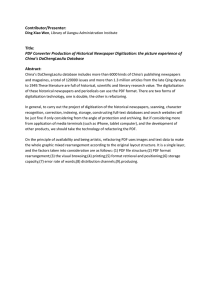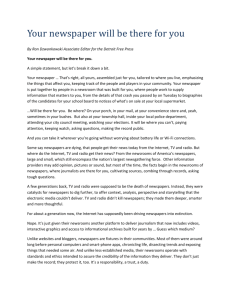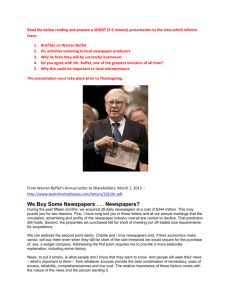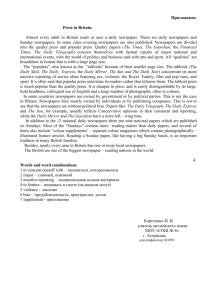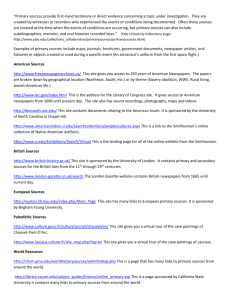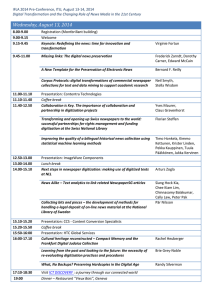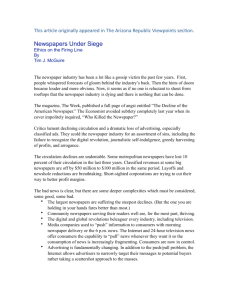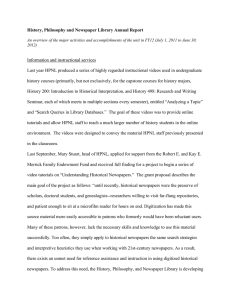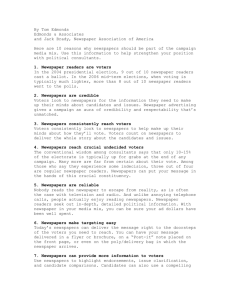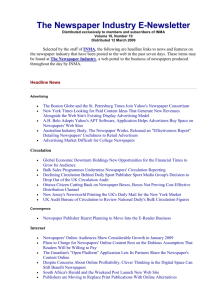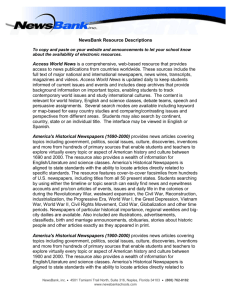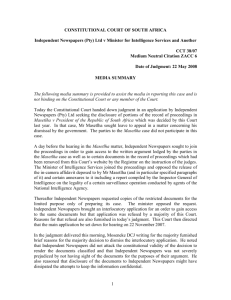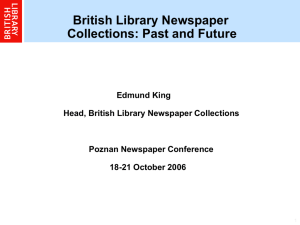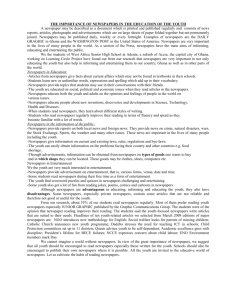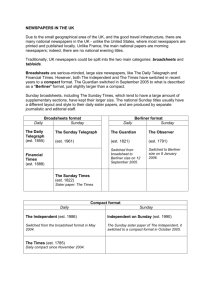Old Newspapers - Family History Conference
advertisement
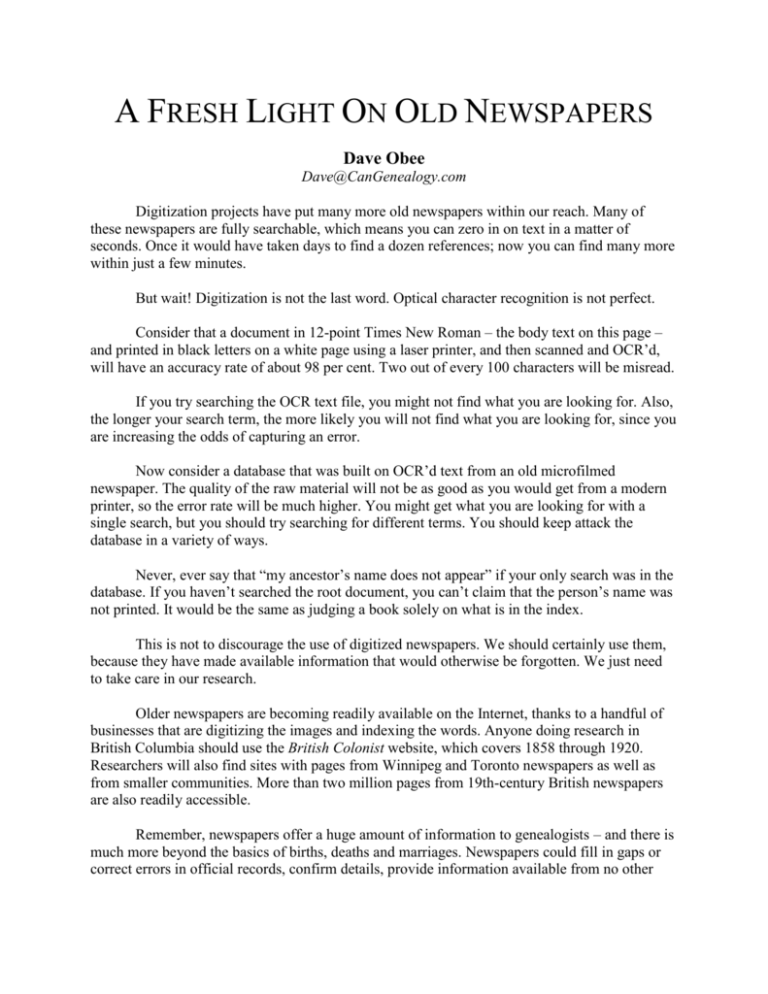
A FRESH LIGHT ON OLD NEWSPAPERS Dave Obee Dave@CanGenealogy.com Digitization projects have put many more old newspapers within our reach. Many of these newspapers are fully searchable, which means you can zero in on text in a matter of seconds. Once it would have taken days to find a dozen references; now you can find many more within just a few minutes. But wait! Digitization is not the last word. Optical character recognition is not perfect. Consider that a document in 12-point Times New Roman – the body text on this page – and printed in black letters on a white page using a laser printer, and then scanned and OCR’d, will have an accuracy rate of about 98 per cent. Two out of every 100 characters will be misread. If you try searching the OCR text file, you might not find what you are looking for. Also, the longer your search term, the more likely you will not find what you are looking for, since you are increasing the odds of capturing an error. Now consider a database that was built on OCR’d text from an old microfilmed newspaper. The quality of the raw material will not be as good as you would get from a modern printer, so the error rate will be much higher. You might get what you are looking for with a single search, but you should try searching for different terms. You should keep attack the database in a variety of ways. Never, ever say that “my ancestor’s name does not appear” if your only search was in the database. If you haven’t searched the root document, you can’t claim that the person’s name was not printed. It would be the same as judging a book solely on what is in the index. This is not to discourage the use of digitized newspapers. We should certainly use them, because they have made available information that would otherwise be forgotten. We just need to take care in our research. Older newspapers are becoming readily available on the Internet, thanks to a handful of businesses that are digitizing the images and indexing the words. Anyone doing research in British Columbia should use the British Colonist website, which covers 1858 through 1920. Researchers will also find sites with pages from Winnipeg and Toronto newspapers as well as from smaller communities. More than two million pages from 19th-century British newspapers are also readily accessible. Remember, newspapers offer a huge amount of information to genealogists – and there is much more beyond the basics of births, deaths and marriages. Newspapers could fill in gaps or correct errors in official records, confirm details, provide information available from no other source, or simply add color and personality to family histories. They are crucial to answering the “why?” questions that we all should ask. For example, a newspaper account might provide information about a person’s relatives, or his birthplace. A newspaper might indicate why someone does not appear in the census for that year – for example, the social page might say that he or she is out of town. A newspaper might provide a census equivalent in a non-census year. Or it may help a researcher understand why or when an ancestor moved to or from a community. A sample bit of text from britishcolonist.ca: he ."ftt in opposition. He did not contest the scat in 1882, but In 1886 was again elected and in 1887 on the death of the Hon. Mr. Smytho he accepted the portfolio of lands and works in the govtjjrnment of the Hon. A. E. B. Davie. .In 1830. he was again returned by hla constituents and was jslvi^n the portfolio of lands and works In the government of the Hon. John Robson. He continued to hold this office under the leadership of the Hon. Theodore DftVle until 1894. From the latter year until ! 1899 he resided In London as Agent General for the province. On rellnaulshlng that post, having also retired from political life, he disposed of his large holdings in the interior and settled down In, Vict<)tla Jnvesting largely in real estate both hero and on the mainland. As a citizen of Victoria the late Mr. Vernon was widely known and correspondingly popular. He 'rt'as one of the founders of the Union Glub, the flag of which was Hying at half mast yesterday as a token of sympathy. In 1877 he married- Miss Branks by Whom he had two children. The- prosperous town of Vernon takes Its name from the deceased. . • So, which search terms would work? LINKS ARE AT WWW.DAVEOBEE.COM © Copyright Dave Obee 2015




